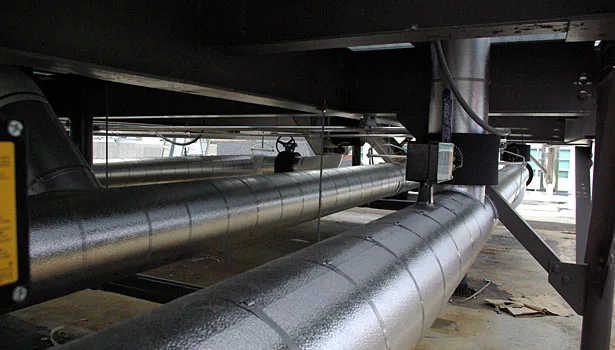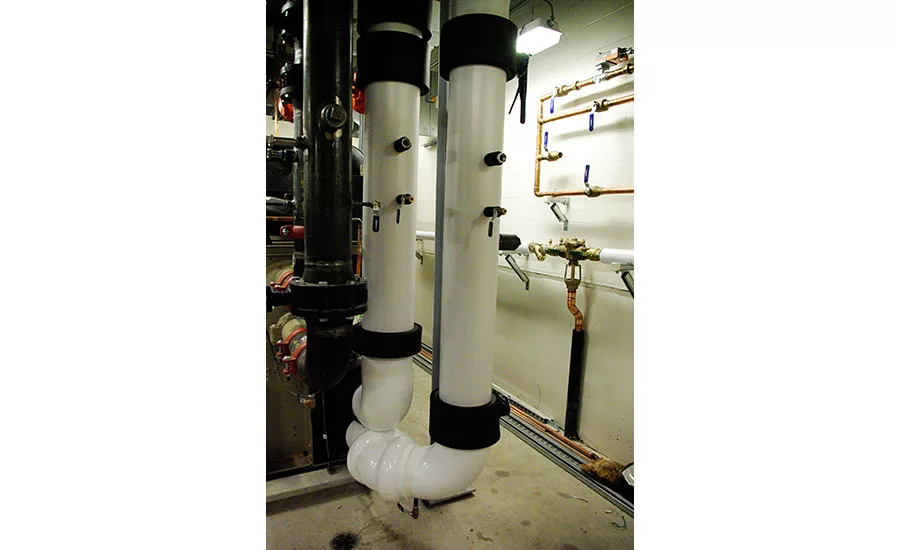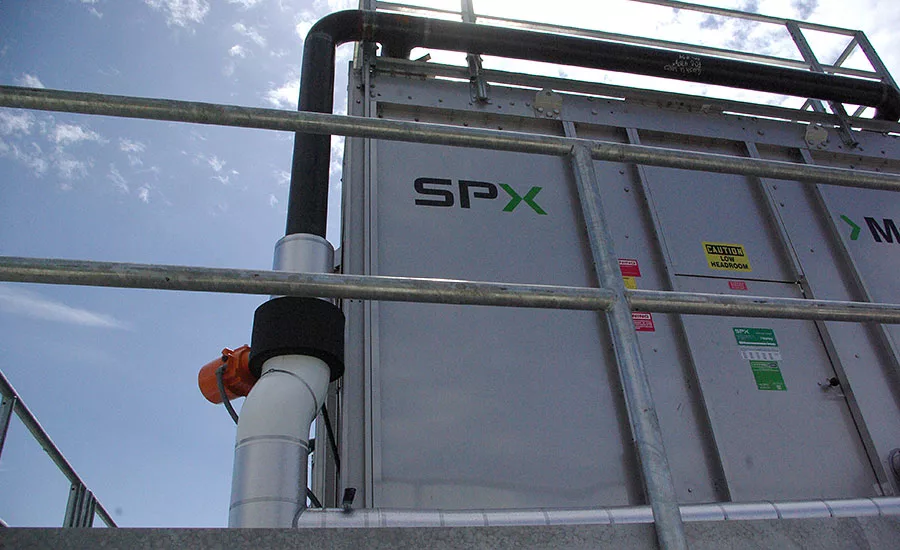Pipe Insulation 101: Different materials fit the bill for different plumbing applications

Pipe insulation also prevents hot pipes carrying steam, for example, from causing undesired heating of the surrounding environment. ISS photo.

Pipe insulation not only plays a major role in making modern facilities inhabitable, but they also do a pretty good job of protecting us from the pipes themselves. ISS photo.

Outside pipes in below-freezing environments are at risk of freezing. Insulation reduces the chance of that and the subsequent blockage. ISS photo.
Pipe insulation is a vital part of a building’s infrastructure that is just as useful as it is underappreciated.
Made from a variety of materials that achieve slightly different end results, the main purpose of all varieties of pipe insulation is to provide a barrier between the contents of a pipe and the outside environment. The protective layer of insulation placed on the outsides of pipes is rarely acknowledged, but the reality is that un-insulated pipes can lead to decreased efficiency, increased condensation, possible freezing and even harm to people who come in contact with the pipes.
Although it has a wide range of applications, pipe insulation can generally be classified as either thermal or acoustic. Thermal insulation is a far greater need for most buildings as only certain pipes produce excessive sound that would need to be insulated by an acoustic barrier.
Applications
One of the primary uses for pipe insulation is condensation control. As with any container full of liquid at below-ambient temperature, colder pipes tend to develop condensed water vapor on their exterior, an undesirable effect that can lead to corrosion and water damage. Pipe insulation developed specifically for condensation control will feature a barrier that keeps water vapor in the air separated from the surface of the pipe, preventing any condensation from forming.
Another major concern involving pipes transporting liquid is freezing. Pipes on building exteriors or in below-freezing environments are at risk of interior freezing that will cause blockage and other various types of damage.
For example, water expands as it freezes, so a water pipe that becomes frozen will often rupture and become completely unusable. The goal of pipe insulation in below-freezing environments is to hold as much heat inside of the pipe as possible as to prevent freezing. Although insulation alone cannot stop the pipe from freezing, it can increase the time it takes for the pipe to freeze in conjunction with a heat trace system on the pipe. With insulation and heat trace cables used on outdoor pipes, the liquid has adequate time to get to its destination before the pipe becomes blocked.
Beyond preventing damage to the building or the pipe, insulation is very commonly used on pipes to increase the energy efficiency of a building.
When pipes are operating at temperatures either far above or far below ambient temperature, a heat transfer occurs as the pipe attempts to adjust itself to the surrounding air temperature. This means that a hot pipe can create an undesirable rise in temperature and vice versa — a cold pipe can unnecessarily cool down a room.
The downsides of heat transfer from pipes include not only discomfort, but also an increase in the amount of energy it takes to restore the building and the pipe to their respective desired temperatures. Thermal pipe insulation can be placed on the exterior of pipes to prevent heat transfer and drastically improve energy efficiency.
When pipes are hot or cold enough to inflict harm on a person who comes in contact with the surface of the pipe, insulation is required to regulate the exterior temperature to a level that is safe to touch. Depending on the extremity of the pipe temperature, the thickness of insulation will vary to achieve this affect.
A final application of pipe insulation is to regulate noise levels from pipes traveling through a building. The conductive nature of pipes makes them especially, and sometimes undesirably, adept at carrying sound from one part of a building to another. Examples can include waste-water or mechanical noise from either end of the pipe.
In this case, acoustic insulation would be used to insulate the pipe and dampen any sound that may emanate from the surface into a room. The insulation also serves as a buffer to prevent any acoustic vibrations from traveling from the pipe to another surface such as a wall or floor.
Materials
With such a wide range of applications, many different material types are used to compose pipe insulation products. Some material types are better suited toward one purpose than another, so insulation materials are commonly rated by their performance in thermal conductivity, water vapor resistance, thickness and density.
Industry-standard materials include mineral or glass wool, rigid or flexible foam, polyethylene or other polyurethane-based insulation types, calcium silicate, cellular glass and aerogel. With so many versatile materials available, the world of pipe insulation is able to offer solutions for nearly any application that building owners and mechanical contractors many encounter.
One such insulation product is a pre-formed, high temperature, abuse-resistant pipe and block insulation with increased structural strength, such as Thermo-12Gold from Industrial Insulation Group. Composed of hydrous calcium silicate, this type of insulation is intended for use on systems operating up to 1,200 degrees Fahrenheit, making it a good choice for high temperature pipes or equipment.
In some cases, insulation manufacturers will blend several materials to come up with hybrid insulation that can be used for multiple applications. Trymer 2000 XP polyisocyanurate insulation from ITW Insulation Systems is one such product that is made of polyurethane modified polyisocyanurate cellular plastic. This type of rigid insulation is useful for a variety of thermal insulation applications due to its improved dimensional stability over a wider range of temperatures than other insulation types. Effective within the temperature range of minus 297 to 300 F, hybrid polyisocyanurate insulation is commonly used on industrial and commercial pipes as well as tanks and vessels, shipping containers, structural panels and even roof insulation.
Advancements in insulation materials have also brought innovations in environmentally sustainable products, such as Earthwool 1000 Pipe Insulation from Knauf Insulation. This molded, high-density insulation is formaldehyde-free, mold-resistant and made from inorganic glass fibers that contribute both sustainability and high performance in applications ranging from zero to 1,000 F. Used to insulate copper and iron pipes in industrial, commercial and institutional applications, this type of insulation offers excellent energy savings, condensation control, indoor air quality and sustainability.
Another insulation type is mold-resistant flexible elastomeric thermal insulation with an expanded closed-cell structure that makes it particularly efficient for preventing heat transfer and condensation drip in chilled-water and refrigeration systems.
One example of this insulation type is APArmaflex pipe insulation from Armacell Engineered Foams. Similar to the inorganic glass wool insulation mentioned above, flexible elastomeric thermal insulation is not made with any formaldehyde and is resistant to mold and mildew, making it a common choice for regulating pipe temperatures.
With so many benefits available from the numerous pipe insulation materials available, building owners and mechanical engineers are in the unique position to match specific types of pipe insulation to their ideal application, maximizing the benefits and minimizing any potential negative consequences that a lack of pipe insulation could create. While pipe insulation still goes widely unrecognized for its importance in building operations, the reality is that modern facilities would be far less dry, safe and efficient without it.
"This article was originally posted on ww.reevesjournal.com."
Looking for a reprint of this article?
From high-res PDFs to custom plaques, order your copy today!






